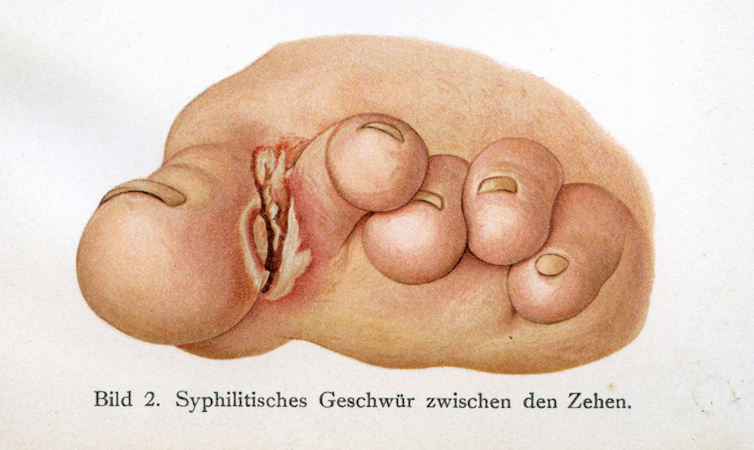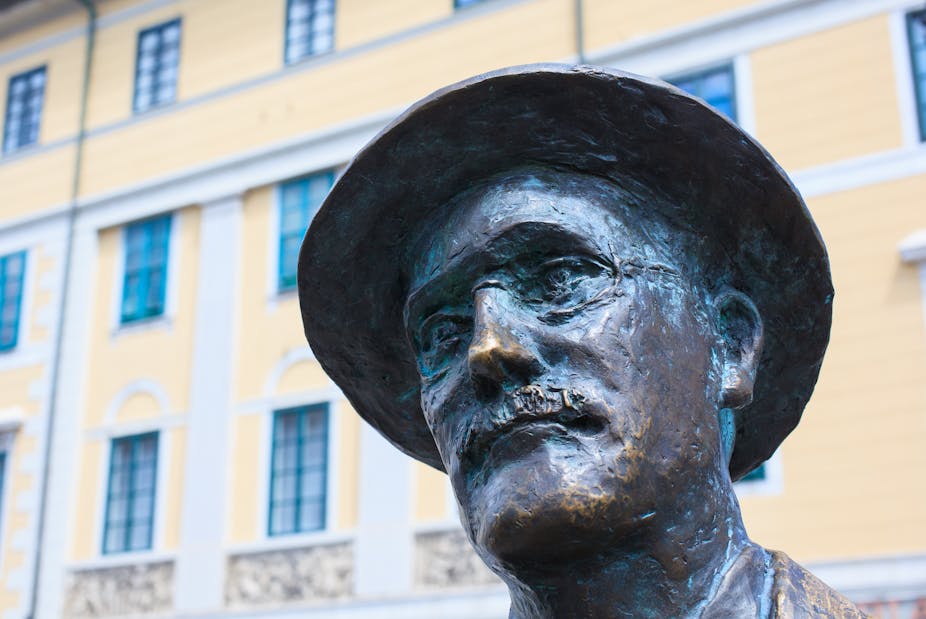According to Jacques Derrida, “nothing can be invented on the subject of Joyce”. Speaking in 1984, he had in mind the sheer comprehensive power of Joyce’s writing: from the capacity of Ulysses to draw in both Homeric epic and everyday life to the engorged language of Finnegans Wake, which sucks elements from across history, literature and culture into its punning complexities.
Derrida attributed predictive powers to these writings. So it should come as no surprise that there are clear precedents to Harvard scholar, Kevin Birmingham’s widely reported claim to have published proof that Joyce had syphilis in The Most Dangerous Book, his forthcoming account of the publication of Ulysses.
There’s nothing new about speculation that Joyce had syphilis: there’s even J.B. Lyons’s essay dedicated to disproving it, Thrust Syphilis Down to Hell (1988). And syphilitic infection would certainly provide one explanation for the origin of the painful and debilitating attacks of irritis which plagued Joyce’s adult life.
Birmingham acknowledges such critical precedents, but advances his own discovery in proof of this hypothetical diagnosis. He argues that Joyce’s eye doctor, Louis Borsch, administered injections of “an obscure French drug called galyl” to him in 1928. The basis for this claim is that Joyce described receiving injections of arsenic and phosphorus in letters written at that time and that galyl is “the only drug” fitting this description and “syphilis is the only disease galyl treats”. Joyce’s medical records, however, were all lost or destroyed.

In other words, there’s no hard proof for this discovery. It rests, as Birmingham concedes, upon “deduction” rather than direct evidence. This doesn’t stop him from depicting a scene in which Borsch prepares Joyce’s injections, or from hypothesising that Borsch remembered administering the same drug to French soldiers during the First World War. There are factual bases for this vivid novelistic writing, but they are carefully tidied away in endnotes. Much of the authority of The Most Dangerous Book and its appeal to a non-academic audience rests on Birmingham’s ability to squeeze convincing scenes out of the scholarship tucked away at the back of the book.
There is another form of precedence for this approach to constructing an argument within Ulysses itself. In chapter nine, one of the central characters, Stephen Dedalus, provides his own theory about the personal sources of Shakespeare’s inspirations. Stephen is all too aware that the factual records are incomplete. Invoking the rhetorical methods of his Jesuit educators (“composition of place”), he fleshes out his theory of Hamlet with an imaginative recreation of the first performance. In place of endnotes, Joyce’s readers are privy to Stephen’s thoughts – his awareness of the gaps and falsifications in what he is saying. The chapter concludes with the blunt concession to his listeners that he doesn’t believe his own theory.

This kind of example is what Derrida meant when he noted with a mixture of admiration and fear that: “All that can be said of Ulysses […] is already anticipated.” It can be hard to find anything to say about Joyce that he didn’t say somewhere in his writings himself. As Stephen debates Shakespeare, he finds his interest in the dramatist’s sex life queried by his audience. The press coverage given to Kevin Birmingham’s supposed discovery testifies to the degree to which such interest in the private lives of writers still persists.
Finnegans Wake takes this a step further in the figure of Shem the Penman, an artist whose disreputable career is patched together out of every criticism ever levelled against Joyce himself. This includes slanders about Shem’s likely affliction with venereal disease, and similar rumours float around about another central character, Humphrey Chimpden Earwicker. Shem may be taking poisonous mercury chloride to cure his infection, or it may be that the corrosive power of this treatment is etching his writings onto his own body. It isn’t clear – the language of the Wake tends to have it both ways (and more).
Syphilis is just not something that may have afflicted Joyce, then. Its history, its status as a source of social shame, the politics of syphilis – these all feature in his writings. Irish Nationalists complained that British soldiers spread venereal disease amongst Dublin’s prostitutes. But Kevin Birmingham indicates that Joyce wrote about such scurrilous matters as a form of confession: the “foibles and ugly truths about Stephen Dedalus and Leopold Bloom” in Ulysses are, Birmingham suggests, “words of contrition”.
I don’t find this convincing, and The Most Dangerous Book is much better on the “dangerous” power of Ulysses elsewhere. Joyce wrote about such matters precisely to probe and question their very status as scurrilous. Ulysses and Finnegans Wake present a threat to conventional morality through their refusal to take conventions for granted. We may never obtain conclusive evidential proof about whether Joyce suffered from syphilis. A diagnosis would indeed fit many of the facts. But if it’s true, and he kept this illness secret, then it’s also true that Joyce mocked and dissected exactly this attempt to preserve dignity in his fictional creations.

